 |
Yellowstriped Oakworm in Gainesville, Florida
Anisota peigleri (Lepidoptera: Saturniidae)
|
Introduction
Outbreak populations of a yellowstriped oakworm, Anisota
peigleri, defoliated laurel, water and Shumard oaks in
Gainesville, Florida from 1996 to 2000. Even when defoliation was not
severe, the falling frass and large numbers of caterpillars were a major
concern for many homeowners. Little is know about this species beyond
the few pages published in the 1996 book Wild Silk Moths of North
America (Tuskes, Tuttle & Collins. Ithaca: Comstock Pub. Assoc.).
In 1999 we started a research project to learn more about the
yellowstriped oakworm. Our research objectives are to document and
describe the biology, dynamics, behavior and control of this insect,
noting especially the similarities and differences with the closely
related orangestriped oakworm, Anisota senatoria.
Please Help - The Gainesville outbreak was located in the area
north of NW 39th Ave between highways SR-121 and US-441. We would like
to know of other areas within the city and across the southeastern
United States where this insect has been or currently is a pest. If you
can help us, please email either John
Foltz or David Serrano with
details of where and when you have encountered this insect.
Illustrated Life History
|
Female Moth |
 |
Moths are present during late August and early September. The
female, illustrated here, is reddish-orange in color and about 3/4 - 1
inch in length. The forewing has a small white spot, a dark line, and
numerous dark speckles. The hind wings are somewhat paler and have an
indistinct line. Females are distinguished from males by their larger
size, threadlike antennae, and the characteristic shape and coloration
of the wings.
|
|
Male Moth |
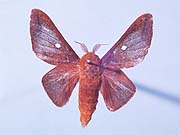 |
Males are smaller than females, the body ranging from 5/8 to 3/4
inch in length. The forewings are dark reddish brown with a small white
spot and a larger whitish translucent patch. The hindwings are mostly
reddish brown. Males have plumose (featherlike) antennae which they use
to locate females by tracking the pheromones females release during
their "calling."
|
|
Adult Male on Leaf |
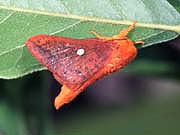 |
These moths are easily approached. During the August-September
flight period they may be found resting on shrubs and on trunks of
trees. They are also commonly seen resting on the walls of buildings.
|
|
Female and a Few Eggs |
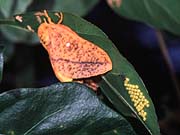 |
Females lay their eggs on the underside of oak leaves in masses
ranging from 10 to 374 eggs. The average mass contains about 150 eggs.
Egg masses are generally located at the ends of the lower branches of
the tree canopy. Sometimes a female can be found resting on the base of
the leaf after the eggs are laid.
|
|
Eggs and Newly Hatched Larvae |
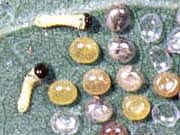 |
Eggs are yellow to orange-yellow in color (black when parasitized),
spherical in shape, and about 1 mm in diameter. The eggs take from 1 to
1 1/2 weeks to hatch. The neonates, present in mid September, are yellow
with a black head and two prominent horns arising from the second
thoracic segment.
|
|
Neonates Feeding |
 |
Caterpillars from an egg mass stay together during the early instars.
The small caterpillars consume only the soft portions of the leaf, leaving
behind the leaf skeleton. Larval clusters can be easily located by looking
in the vicinity of skeletonized leaves.
|
|
First and Second Instars |
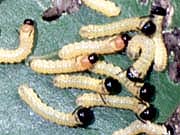 |
After several days of feeding and growing, the neonates shed their
head capsule and skin and become second stage larvae. The second stage
caterpillars retain the yellow color.
|
|
Third and Fourth Instars |
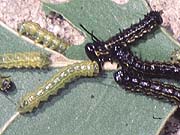 |
During the third and fourth stages the caterpillars change from the
yellow to a black color. Eventually, larvae become black-bodied with
yellow stripes running down their sides.
|
|
Fully Grown Larva |
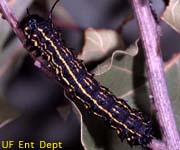 |
In late October the larvae are fully grown and may be 2 inches long.
All have the black coloration with yellow stripes. The black horns
arising from the second thoracic segment are still prominent. A row of
small spines runs down the length of the body behind each of the horns.
|
|
Pupal Stage |
 |
Pupae, like adults, vary in size according to sex. Male pupae range
from 3/4 to 1 inch and female pupae range from 1 to 1 1/4 inch in
length. The pupae reside in the soil about 2-3 inches deep,
"overwintering" for about ten months. Moths emerge the next year to
begin the cycle again.
|
|
Defoliation |
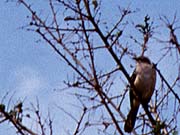 |
Oakworm populations occasionally reach levels that completely
defoliate host trees. Most oaks can tolerate one such defoliation with
little impact on their health. Repeated defoliations, however, will
weaken the trees and lead to infestation by secondary insects and
pathogens.
Here are some steps for promoting tree vigor and reducing insect populations:
- Provide appropriate water and nutrients to the tree throughout
the growing season.
- Watch for and remove eggs and young colonies from the lower
branches.
- If large numbers of caterpillars are too high for removal,
contact a pest control operator for application of an appropriate
insecticide.
|
Created 10/11/99 by David Serrano and
John Foltz. Last modified 28 June 2002.












